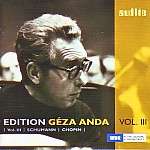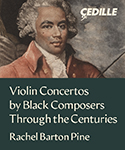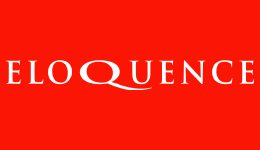Audite’s third of four double-CD sets devoted to Géza Anda’s Cologne Radio broadcasts mostly features solo works otherwise available in the pianist’s commercial catalog. However, the 1954/’60 broadcasts benefit from a warmer, more resonant, and dynamically wide sonic image that reveals the pianist’s characteristically gaunt sonority in more flattering and three-dimensional light than usual, and all to the music’s benefit.
Kreisleriana sports lightness and razor-sharp clarity similar to Anda’s commercial versions, although he takes more chances for his radio audience, resulting in a few momentary and (for Anda) rare technical spills. However, I still can’t accept his absurdly brisk tempo for the final movement’s main theme. Anda’s rubato conceits mostly pay off in the Symphonic Etudes, notwithstanding the finale’s unsubtle accelerations. As usual, Anda opts for the standard text, but includes the fourth and fifth posthumous variations.
In comparing this 1960 Carnaval to Anda’s earlier commercial EMI recording (reissued by Testament), I find that Anda’s penchant for zooming in on and pondering over details has grown more subjective with time, especially in lyrical movements. For example, his lollygagging over the “Chopin” movement has nothing to do with the composer’s proscribed Agitato, while “Eusebius” threatens to expand beyond recognition, and “Promenade” doesn’t soar as it should, but rather floats in the proverbial dead sea. On the other hand, the brisk, business-like “Papillons” boasts breathtaking digital poise and control. Like Rachmaninov, Cortot, Gieseking, and Katchen, Anda plays the forbidden “Sphinxes” movement. The full-bodied, beautifully sung out F-sharp Romanze (Op. 28 No. 2) provides a small yet treasurable addition to Anda’s recorded repertoire.
Reviewing Anda’s DG Chopin Preludes, I observed how the performances “penetrate through decades of accumulated interpretive sentiment, and reveal the music’s deep-rooted classical logic via brisk tempos, polyphonic astuteness, and fastidious ornaments.” The same words apply to his earlier, more impetuous and emotionally charged WDR aircheck. Lastly, a 1955 rendition of Chopin’s Op. 25 Etudes finds Anda on more inspired, poetic form than his relatively cut-and-dried (though no less technically impressive) Eurodisc studio and Ermitage live versions from 10 years later; perhaps the superior WDR sonics factor into my opinion. Chopin Etude aficionados should take special notice of the F minor’s insightfully contoured part writing, the G-flat “Butterfly” Etude’s playful bounce, the thorough attention to Chopin’s carefully differentiated textures in the E minor, the B minor “Octave” Etude’s ravishing legato phrasing, and a stupefyingly fast, utterly effortless A minor to rival the young Ashkenazy’s paradigm. If you admire Géza Anda (and I do, reservations and all), seriously consider this release.
































